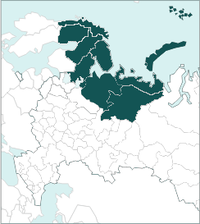This article includes a list of general references, but it lacks sufficient corresponding inline citations. (March 2013) |
Barents Region | |
|---|---|
 | |
| Population (2012)[1] | |
| • Total | 5 206 000 |
| • Density | 2.9/km2 (8/sq mi) |
The Barents Region is a name given, by advocates of establishing international cooperation after the fall of the Soviet Union, to the land along the coast of the Barents Sea, from Nordland county in Norway to the Kola Peninsula in Russia and beyond all the way to the Ural Mountains and Novaya Zemlya, and south to the Gulf of Bothnia of the Baltic Sea and the great lakes Ladoga and Onega. Among the projects is the Barents Road from Bodø in Norway through Haparanda in Sweden and Finland to Murmansk in Russia. The region has six million inhabitants on 1.75 million km2; three quarters of both belong to Russia.
The regional cooperation was formally opened on 11 January 1993, initiated by Norway under foreign minister Thorvald Stoltenberg. It includes Nordland, Troms, and Finnmark counties in Norway; Västerbotten County and Norrbotten County in Sweden; Lapland region, Northern Ostrobothnia, Kainuu, and North Karelia in Finland; and Murmansk Oblast, Arkhangelsk Oblast, Komi Republic, Republic of Karelia, and Nenets Autonomous Okrug in Russia. The four countries take turns at chairing the cooperation. Norway's participation is coordinated from the Norwegian Barents Secretariat in Kirkenes. Sweden's and Finland's participation is administrated from the county administrations in Umeå (Västerbotten) and Rovaniemi (Lapland). In January 2008 there was established an International Barents Secretariat which is to provide technical support for the multilateral coordinated activities within the framework of the Barents Euro-Arctic Council and the Barents Regional Council. This Secretariat is located in Kirkenes in the same building as the Norwegian Barents Secretariat.
- ^ Population Statistic. The Barents Euro-Arctic Council Archived 2016-03-04 at the Wayback Machine. Referenced on the 01.08.2016